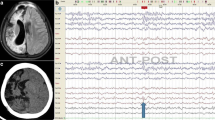Abstract
Background
Hemispheric brain lesions are commonly associated with early onset of catastrophic epilepsies and multiple seizure types. Hemispheric surgery is indicated for patients with unilateral intractable epilepsy. Although described more than 50 years ago, several new techniques for hemispherectomy have only recently been proposed aiming to reduce operatory risks and morbidity.
Materials and methods
We present the clinical characteristics, presurgical workup, and postoperative outcome of a series of pediatric patients who underwent hemispherectomy for medically intractable epileptic seizures. Thirty-nine patients with medically intractable epilepsy underwent surgery from 1996 to 2005.
Results and discussion
We analyzed demographic data, interictal and ictal EEG findings, age at surgery, surgical technique and complications, and postsurgical seizure outcome. There were 74.4% males. Tonic and focal motor seizures occurred in 30.8 and 20.5% of the patients. Most frequent etiologies were Rasmussen encephalitis (30.8%) and malformation of cortical development (23.1%). Postsurgical outcomes were Engel classes I and II for 61.5% of the patients. In general, 89.5% of the patients exhibited at least a 90% reduction in seizure frequency. All patients had acute worsening of hemiparesis after surgery. Basically, two surgical techniques have been employed, both with similar results, although a trend has been noted toward one of the procedures which produced consistently complete disconnection. Patients with hemispheric brain lesions usually have abnormal neurological development and intractable epilepsy. When video-EEG monitoring and magnetic resonance imaging show unilateral disease, the patient may evolve with a good surgical outcome. We showed that a marked reduction in seizure frequency may be achieved, with acceptable neurological impairments.
Similar content being viewed by others
References
Carson BS, Javedan SP, Freeman JM, Vining EP, Zuckerberg AL, Lauer JA, Guarnieri M (1996) Hemispherectomy: a hemidecortication approach and review of 52 cases. J Neurosurg 84(6):903–911
Chugani HT, Shewmon DA, Peacock WJ, Shields WD, Mazziotta JC, Phelps ME (1988) Surgical treatment of intractable neonatal-onset seizures: the role of positron emission tomography. Neurology 38(8):1178–1188
Dandy W (1928) Removal of right cerebral hemisphere for certain tumor with hemiplegia. JAMA 90:823–825
Delalande O, Pinard J-M, Basdevant C et al (1992) Hemispherotomy: a new procedure for central disconnection. Epilepsia 33(Suppl 3):99–100
Devlin AM, Cross JH, Harkness W, Chong WK, Harding B, Vargha-Khadem F, Neville BG (2003) Clinical outcomes of hemispherectomy for epilepsy in childhood and adolescence. Brain 126(Pt 3):556–566
Döring S, Cross H, Boyd S, Harkness W, Neville B (1999) The significance of bilateral EEG abnormalities before and after hemispherectomy in children with unilateral major hemisphere lesions. Epilepsy Res 34(1):65–73
Duchowny M, Jayakar P, Resnick T, Harvey AS, Alvarez L, Dean P, Gilman J, Yaylali I, Morrison G, Prats A, Altman N, Birchansky S, Bruce J (1998) Epilepsy surgery in the first three years of life. Epilepsia 39(7):737–743
Engel J Jr (1993) Protocols for the University of California, Los Angeles. In: Engel J Jr (ed) Surgical treatment of Epilepsies. Raven, New York, pp 743–745
Gonzalez-Martinez JA, Gupta A, Kotagal P, Lachhwani D, Wyllie E, Luders HO, Bingaman WE (2005) Hemispherectomy for catastrophic epilepsy in infants. Epilepsia 46(9):1518–1525
Jonas R, Nguyen S, Hu B, Asarnow RF, LoPresti C, Curtiss S, de Bode S, Yudovin S, Shields WD, Vinters HV, Mathern GW (2004) Cerebral hemispherectomy: hospital course, seizure, developmental, language, and motor outcomes. Neurology 62(10):1712–1721
Kossoff EH, Vining EP, Pillas DJ, Pyzik PL, Avellino AM, Carson BS, Freeman JM (2003) Hemispherectomy for intractable unihemispheric epilepsy etiology vs outcome. Neurology 61(7):887–890
Maehara T, Shimizu H, Kawai K, Shigetomo R, Tamagawa K, Yamada T, Inoue M (2002) Postoperative development of children after hemispherotomy. Brain Dev 24(3):155–160
Ohtsuka Y, Ohno S, Oka E (1999) Electroclinical characteristics of hemimegalencephaly. Pediatr Neurol 20(5):390–393
Peacock WJ, Wehby-Grant MC, Shields WD, Shewmon DA, Chugani HT, Sankar R, Vinters HV (1996) Hemispherectomy for intractable seizures in children: a report of 58 cases. Childs Nerv Syst 12(7):376–384
Pulsifer MB, Brandt J, Salorio CF, Vining EP, Carson BS, Freeman JM (2004) The cognitive outcome of hemispherectomy in 71 children. Epilepsia 45(3):243–254
Shimizu H, Maehara T (2000) Modification of peri-insular hemispherotomy and surgical results. Neurosurgery 47(2):367–373
Smith JR, Fountas KN, Lee MR (2005) Hemispherotomy: description of surgical technique. Childs Nerv Syst 21(6):466–472
Smith SJ, Andermann F, Villemure JG, Rasmussen TB, Quesney LF (1991) Functional hemispherectomy: EEG findings, spiking from isolated brain postoperatively, and prediction of outcome. Neurology 41(11):1790–1794
Villemure JG, Mascott CR (1995) Peri-insular hemispherotomy: surgical principles and anatomy. Neurosurgery 37:975–981
Yoshioka H, Hasegawa K, Sakamoto T, Kihara M, Masuda A, Adachi S, Sawada T, Shimizu H (1999) Modified functional hemispherectomy in hemimegalencephaly. Brain Dev 21(2):125–128
Wyllie E, Comair YG, Kotagal P, Bulacio J, Bingaman W, Ruggieri P (1998) Seizure outcome after epilepsy surgery in children and adolescents. Ann Neurol 44(5):740–748
Acknowledgements
The authors thank the epilepsy fellows, neurology residents, and staff of the Epilepsy Outpatient Clinics and Video-EEG Monitoring Unit of the Hospital das Clínicas da Faculdade de Medicina de Ribeirão Preto/USP. This work was supported by FAPESP, CNPq, and FAEPA.
Author information
Authors and Affiliations
Corresponding author
Rights and permissions
About this article
Cite this article
Terra-Bustamante, V.C., Inuzuka, L.M., Fernandes, R.M.F. et al. Outcome of hemispheric surgeries for refractory epilepsy in pediatric patients. Childs Nerv Syst 23, 321–326 (2007). https://doi.org/10.1007/s00381-006-0212-6
Received:
Published:
Issue Date:
DOI: https://doi.org/10.1007/s00381-006-0212-6




